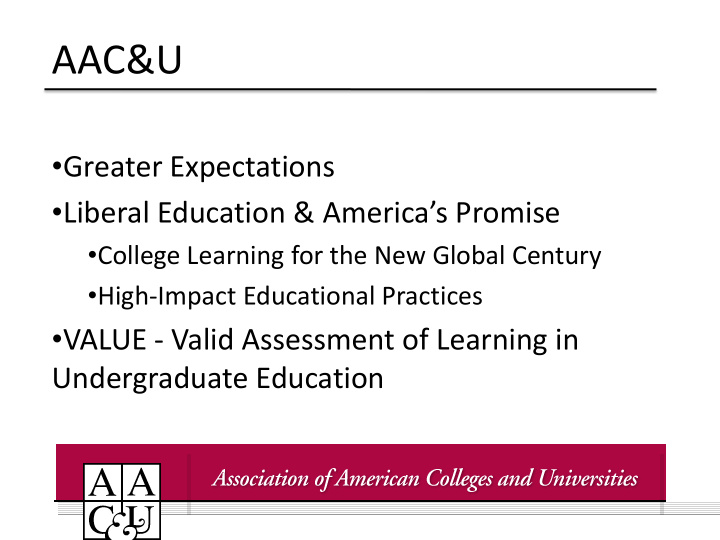



AAC&U • Greater Expectations • Liberal Education & America’s Promise • College Learning for the New Global Century • High-Impact Educational Practices • VALUE - Valid Assessment of Learning in Undergraduate Education
Liberal Education and America’s Promise (LEAP) “LEAP is a decade-long national initiative launched by the Association of American Colleges and Universities (AAC&U) in 2005 to align the goals for college learning with the needs of the new global century . Extending the work of AAC&U’s Greater Expectations initiative, LEAP seeks to engage the public with core questions about what really matters in college , to give students a compass to guide their learning, and to make the aims and outcomes of a liberal education – broad knowledge, intellectual and practical skills, personal and social responsibility, and integrative learning – the expected framework for excellence at all levels of education. The LEAP initiative is especially concerned with students who, historically, have been underserved in higher education.”
“This report on “High-impact educational practices” speaks directly to what is arguably our most important national challenge in higher education: helping America’s extraordinarily diverse students reap the full benefits – economic, civic, and personal – of their studies in college .” - Carol Geary Schneider
“…the long-term ‘college success’ question encompasses not only whether students have earned a degree, but also whether graduates are in fact achieving the level of preparation – in terms of knowledge, capabilities, personal qualities – that will enable them to both thrive and contribute in a fast-changing economy and in turbulent, highly demanding global, societal, and often personal contexts .” - Carol Geary Schneider
“how frequently, and with what results, do students engage in educational practices – curricular, cocurricular, and pedagogical – that provide them with realistic opportunities to actually develop the kinds of learning they need ? How does such participation relate to expected learning outcomes?” - Carol Geary Schneider
First Year Retention at USD USD three-year average: • Fall to Spring = 95.1% • Fall to Fall = 85% USD goal by 2012: • Fall to Fall = 90%
USD Retention Compared to Peers • 96% - USC • 94% - Villanova • 93% - Santa Clara • 91% - Fordham • 89% - Pepperdine • 88% - Seattle University • 87% - Loyola Marymount • 87% - University of Dayton • 85% - USD • 83% - USF • 83% - Seton Hall
Retention & Student Success Who leaves USD at higher rates? • Black students - 80.5% (n=20.7) • Out-of-state – 81.2% (n=426.3) • American Indian students – 81.3% (n=13) • Non-Catholic students – 82.5% (436.7) • First generation students – 83.7% (n=145.3)
Retention & Student Success Who stays at USD at higher rates? • Commuter students – 88.4% (n=43.3) • Students from CA – 88.2% (n=553) • Honors – 87.2% (n=95.7) • Catholic – 87.1% (n=542.7)
USD Six-Year Graduation Rates Compared to Peers • 88% - Villanova • 87% - USC • 85% - Santa Clara • 80% - Pepperdine • 79% - Fordham • 78% - Loyola Marymount • 76% - University of Dayton • 74% - USD • 71% - Seattle University • 67% - USF • 60% - Seton Hall
Six-Year Graduation Rates Who graduates USD at lower rates? • Black students – 55.1% (n=23) • International students - 65.9% (n=14.7) • Scholarship athletes – 68.6% (n=28.7) • Out-of-state – 70.6% (n=463.3)
Six-Year Graduation Rates Who graduates at USD at higher rates? • Honors – 83.5% (n=99) • Students from CA – 77.5% (n=574.3) • Commuter students – 76.7% (n=64.3) • American Indian – 76.6% (n=15.7) • Catholic – 76.3% (n=595)
Retention & Student Success Why are students leaving? • Financial Reasons – tuition too high – do not want more debt – insufficient financial aid • Student body composition and culture – students too “cliquey” – uncomfortable with overall student culture – not enough economic diversity
High-Impact Educational Practices • First-year seminars and experiences • Common intellectual experiences • Learning communities • Writing intensive courses • Collaborative assignments and projects • Undergraduate research • Diversity/global learning • Service-learning, community-based learning • Internships • Capstone courses and projects
Recommend
More recommend